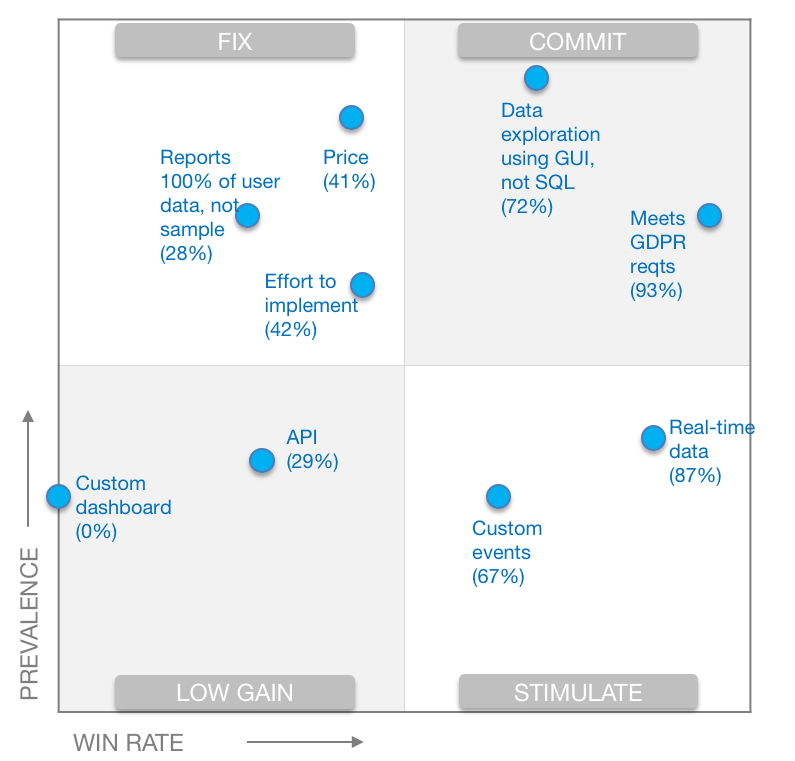Lost deal reviews. Loss reviews. Win/Loss reviews.
With the noble intent to learn from recent losses, these meetings can be a powerful tool for Sales to generate cross-functional alignment around issues impacting the business.
But they too often end up as morale killers and a waste of exec time.
When was the last time Product Management updated their roadmap following one of your lost deal reviews? Has a lost deal review triggered Product Marketing to rush an update to battle cards and field training for an emerging competitor?
If your lost deal reviews aren’t driving changes to cross-functional plans and programs, here’s a tip: Use CRM data to quantify the scope of the issues surfaced by your lost deal reviews. An issue that has factored into multiple losses, across your pipeline, will drive quicker and more substantial change to cross-functional plans.
Using CRM Data As A Lever To Action
As a sales leader with daily exposure to buyers and sellers, you can probably name at least ten to twenty deficits in Product and GTM that have caused you to lose an opportunity. But which of these issues was most prevalent across all the opportunities you’ve Closed-Lost in the past one or two quarters? Answering that question requires a lot of data, ideally from your CRM.
I spent a decade in Product Management roles, and while I wanted to help reps who needed the promise of a feature enhancement to win a deal, my #1 responsibility was to improve overall results in the markets we targeted.
I predict Product and Engineering leaders will respond with interest — but no decisive action — when a lost deal review profiles one or two or three deals that were lost because a main competitor’s implementation of Feature Z is better.
But if Product, Engineering, and other execs are also told that the win rate against this main competitor is now half what it was two quarters ago, and Feature Z was a top 5 decision criterion in 90% of recent matchups against this competitor, my bet is they’ll be reprioritizing items in the product plan.
So get numbers from Sales Ops to show that losses like these are a bigger problem than just the handful of deals presented at the meeting (…and, even better, that they’re affecting outcomes with ICP buyers).

How To Handle Missing Data
CRM hygiene is notoriously bad. Too many CRM implementations are contaminated with bad data. So what should you do if you don’t have key facts—like top decision criteria and consideration set—in your CRM? Here are three options.
- Ask your reps. (As fast as one week turnaround, but low accuracy because the data may be inaccurate or poorly remembered.) For each opportunity closed in the past one or two quarters, require your reps to add decision criteria and consideration set to your CRM. A survey tool or a spreadsheet will be faster than setting up pick lists in your CRM. Improve accuracy by interviewing each rep, walking through the deal history to reactivate memories.
- Ask your buyers. (Four to six weeks turnaround, and highly accurate.) Interviewing buyers will take more time, but provide much greater accuracy (assuming you don’t involve anyone from the sales process in the interviews). Sales teams often enlist their Product Marketing team or an independent win/loss analysis consultant like Growth Velocity to conduct these interviews. A baseline of 20 to 30 buyer interviews is usually sufficient to reveal not just the prevalence of an issue but also why and how to fix it.
- Instrument your CRM. (Requires substantial effort and time, but can have the highest accuracy and ongoing impact.) Capturing the data accurately will require substantial changes to CRM configuration, rep training, and ongoing enforcement. But sales teams that have been trained to use a qualification process like MEDDIC are already gathering some of the key data points you’ll need, such as use case and decision criteria. The leader of the CI program at a large enterprise technology vendor described to me their “four year journey” to using CRM data, all sourced by reps, in ways like I’ve described above. He told me “it was a very painful process to get there” but they’re now having real success: they close deals 14-20 days sooner, and their deals are 25-50% larger.
Be careful what you ask for
At the opposite end of the spectrum, some Product and Marketing teams are highly responsive, even over-responsive to Sales input. Then there’s the corollary of being careful what you ask for. Because a quick response now to re-prioritize a program or feature enhancement will cause delays if you later identify a higher priority issue.
Data from a CRM helps in these situations, too, by providing more data and better perspective for prioritization.
It’s healthy to run experiments
Cross-functional alignment was the most popular topic among the sales leaders I engaged with last year. Sales leaders clearly want their team’s experience with buyers to influence Product and Marketing priorities.
If you want better cross-functional alignment, try this one improvement — using CRM data to quantify the prevalence of the issues — to see how much more action, not just interest, your lost deal reviews can generate.
Related Posts
Sales Win Loss Analysis: Why Data-Driven Leaders Are Leveling Up
Sales win loss analysis helps leaders make data-driven decisions. What’s working and where can we double-down? What isn’t working, and how do we fix it?
Win/Loss Analysis Reports: 3 Things You’ll Learn
Which aspects of your product offering and buying experience are helping drive sales? And which aspects are hindering sales? This is what enterprise and mid-market software companies often struggle to understand. A good win/loss analysis report will provide the answers to these questions.
Three Reasons Sales Leaders Want Even More Data About Their Buyers
While B2B sales teams are literally swimming in data, it’s not enough. Data-driven sales leaders are using input directly from buyers to find new ways to improve win rate and lead with conviction.




